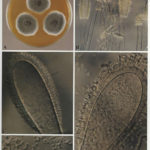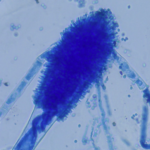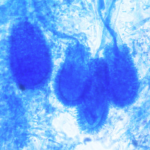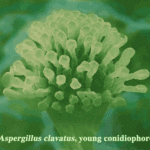ID: 9
Medically significant: yes
Classification agreed: y
Contentious not verified: n
In ncbi taxonomy database: y
Available from atcc: y
CBS: y
Previous CBS: unknown
Sexual CBS: unknown
Contentious name: unknown
Previous name, contentious name: unknown
Sexual form exists: unknown
Sexual form contentious name: n
Sexual form in ncbi taxonomy database: n
Previous name in NCBI taxonomy database: n
Previous name available at ATCC: unknown
Reference (original paper):
Desmazières, J.B.H.J. 1834. Descriptions et figures de six hyphomycètes inédites à ajouter à la flore Française. Annales des Sciences Naturelles Botanique. 2:69-73
Medical significance update: The First Case of Total Dystrophic Onychomycosis Caused by Aspergillus clavatus Resistant to Antifungal Drugs. Falahati M, Ghojoghi A, Abastabar M, Ghasemi Z, Farahyar S, Roudbary M, Hedayati MT, Armaki MT, Hoseinnejad A. Mycopathologia. 2016 Apr;181(3-4):273-7. doi: 10.1007/s11046-015-9954-6.
Taxonomic family: Fungi, Ascomycota, Pezizomycotina, Eurotiomycetes, Eurotiomycetidae, Eurotiales, Trichocomaceae, Aspergillus
Species images:
-
A Colonies on MEA after one week;B conidial heads and tip of conidiophore, x 230; C conidial head, x920; E conidial head, x920. Copyright B.Flannigan, R Samson & JD Miller (From Microorganisms in home and indoor work environments, Published by Taylor and Francis)

-
microscopic characters Conidiophore stipes(C)1300-2800um long:Vesicles(V)40-70um wide,clavate:Phialides(Ph) uniseriate:Conidia(Con)3.5-4.0um long,smooth walled.

-
growing on contaminated barley malt. The deep blue-green heads made up of chains of conidia are seen on the left. On the right, conidiophores from which conidial chains are developed show typical clavate heads. Stain- Cotton blue in Lactophenol.

-
Left= an agar air plate exposed for 2 minutes after the barley had been turned. showing numerous colonies of the fungus following incubation at 26C on 2% malt agar.Right= A sputum sample taken from a maltworker after exposure showing many fungal colonies when cultured on agar. His commensal yeast flora is seen towards the right base as cream/white colonies.

Currently accepted name (anamorph): A. clavatus
Index Fungorum: Link
Mycobank: Link
Taxonomic family: Fungi, Ascomycota, Pezizomycotina, Eurotiomycetes, Eurotiomycetidae, Eurotiales, Trichocomaceae, Aspergillus
Computed content type (Species): Species
Species
-
Title
Author
Medically significant
Mycobank
Index fungorum
-
Al-Musallam, Revision of the black Aspergillus species: 30 (1980)
-
Horie, Y. 1980. Ascospores ornamentation and its application to the taxonomic re-evaluation in Emericella. Transactions of the Mycological Society of Japan. 21:483-493
n
-
Fennell, D.I.; Raper, K.B. 1955. New species and varieties of Aspergillus. Mycologia. 47:68-89
n
-
Udagawa & Takada, Bulletin of the National Science Museum Tokyo 14 (3): 503 (1971) [MB#265226]
-
Kobayasi, Y. 1971. Mycological reports from New Guinea and the Solomon Islands (1-11). Bulletin of the National Science Museum Tokyo. 14(3):503
-
Udagawa, S.; Uchiyama, S. 2002. Neocarpenteles: a new ascomycete genus to accommodate Hemicarpenteles acanthosporus. Mycoscience. 43(1):3-6
-
Subramanian, C.V. 1972. The perfect states of Aspergillus. Current Science. 41:755-761
-
Alkaloid and anthraquinone derivatives produced by the marine-derived endophytic fungus Eurotium rubrum. Yan, Hui-Jiao; Li, Xiao-Ming; Li, Chun-Shun; Wang, Bin-Gui. Helvetica Chimica Acta (2012), 95(1), 163-168
-
Vuillemin, P. 1920. Nouvelles souches thermophiles d’Aspergillus glaucus. Bulletin de la Société Mycologique de France. 36:127-136
-
Structure of aspochalasin H, a new member of the aspochalasin family. Tomikawa, Taijiro; Shin-Ya, Kazuo; Seto, Haruo; Okusa, Noriyuki; Kajiura, Takayuki; Hayakawa, Yoichi. Journal of Antibiotics (2002), 55(7), 666-668.
n/an/a

 ,
,  ,
, 
